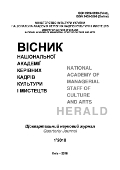COMPARING THE MOTOR SKILLS OF 4 AND 5-YEAR-OLD EDUCABLE MENTALLY RETARDED GIRLS WITH THEIR PEER GROUPS USING PEABODY DEVELOPMENTAL MOTOR SCALES
DOI:
https://doi.org/10.32461/2226-3209.1.2018.178354Анотація
Abstract. Objective: The development of motor skills in preschool children plays a fundamental role in
subsequent learning, with some researchers believing that motor skill learning determines future learning, and superior mental processes result from the proper development of the perceptual-motor systems. Motor performance in children affects their learning skills, so the lack of proper motor activity is a hurdle involved in a child’s explorative, playing and learning experiences. Method This descriptive, analytical study is cross-sectional in nature. The researcher described and analyzed the motor skill of two subject groups, one consisting of normal girls and the other consisting of educable mentally retarded girls, aged 4 to 5, across Tehran’s kindergartens. Multistage randomization was performed to select a statistical population totaling 60 subjects. The test consisted of two parts; one assessed the gross motor skills and the other assessed the fine motor skills. Results: Data were analyzed by the analysis of variance and t-test. The results indicated that there was a statistically significant deference between 4 and 5-year old normal and educable mentally retarded girls. There was not a significant difference between 5-year old normal and educable mentally retarded girls in terms of the mean value of the fine and gross motor skills and their sub-categories. There was not a significant difference between 4 and 5-year old normal girls
in the fine and gross skills based on the Peabody test. Conclusion: Mentally retarded girls had lower ability at gross and soft motor skills than normal girls, and the Peabody test was a proper method to examine this property.
Keywords: Motor skills, mentally retarded children, Peabody test
Посилання
Barsch RH. Perceptual-motor curriculum: Special child publications; 1968.
Cratty BJ. Adapted physical education for handicapped children and youth: Love Publishing Company; 1980.
. French RW, Jansma P. Special physical education: Merrill Publishing Company; 1982.
Boucher BH, Doescher SM, Sugawara AI. Preschool children's motor development and self-concept. Perceptual
and motor skills. 1993;76(1):11-7.
Ayres AJ. Improving academic scoresthrough sensory integration. Journal of Learning Disabilities.
;5(6):338-43.
Harris SR, Heriza CB. Measuring infant movement: Clinical and technological assessment techniques. Physical
therapy. 1987;67(12):1877-80.
Akbar Fahimi N. EDPA Examination in Normal 1-6 Year-Old Girls in Tehran. Master's Thesis.
;University of Social Welfare and Rehabilitation Sciences. [In Persian]
Fulks M-AL, Harris SR. Predictive accuracy of the Miller Assessment for Preschoolers in children with
prenatal drug exposure. Physical & occupational therapy in pediatrics. 2005;25(1-2):17-37.
Ratzon N, Greenbaum C, Dulitzky M, Ornoy A. Comparison of the motor development of school-age children
born to mothers with and without diabetes mellitus. Physical & occupational therapy in pediatrics. 2000;20(1):43-57.
Folio MR. Peabody developmental motor scales. DLM Teaching Resources. 1983.
Tavasoli A, Azimi P, Montazari A. Reliability and validity of the Peabody Developmental Motor Scales-for
assessing motor development of low birth weight preterm infants. Pediatric neurology. 2014;51(4):522-6. [In Persian].
Dotty A, Mcewen I, Parker D. effect off testing content on ball skill performance in five years old children with
out developmental delay acupational therapy 1998;73(3):312-8.
Case-Smith J, Allen AS, Pratt PN. Occupational therapy for children: Mosby St. Louis; 2001.
Palison R, Kolob T, Haley S. validity of the Peabody development gross motor scale as an evaluation measure
of infants receiving physical therapy physical ther Physical Therapy. 1998;75(11):939-48
Margo N, Susan K, Steven D. Effect of otitis media with effusion on gross motor ability in preschool – age
children. pediaterics. 1997;99(3):334-7.
Sommerfelt K, Sonnander K, Skranes J. neuropsychologic and motor function in small-for-gestation
preschooler. Pediatric Neural. 2002;26(3):186-91.
Ghasemi M. Comparison of Girls with Down Syndrome and Down Syndrome in Driving Ozer Tesque Skill
Test. Thesis Master's Degree in Psychology. 1995;University of Tehran, Faculty of Psychology and Educational Sciences
[In Persian].
Babapur J. Comparison of Normal and Dyslexic Students Using His Lincoln Test Zoretsky. Master Thesis.
:62-9. [In Persian].
Derekhsanrad A. Standardization of pivotal motor developmental test in preschool girls MSc Thesis. 2004. [In
Persian].
Crowe W, Auxter D, Pyfer J. adapted physical education and research. mosby company. 1981;4th edition.
##submission.downloads##
Номер
Розділ
Ліцензія
Автори, які публікуються у цьому журналі, погоджуються з наступними умовами:
1. Автори залишають за собою право на авторство своєї роботи та передають журналу право першої публікації цієї роботи на умовах ліцензії Creative Commons Attribution License International CC-BY, котра дозволяє іншим особам вільно розповсюджувати опубліковану роботу з обов'язковим посиланням на авторів оригінальної роботи та першу публікацію роботи у цьому журналі.
2. Автори мають право укладати самостійні додаткові угоди щодо неексклюзивного розповсюдження роботи у тому вигляді, в якому вона була опублікована цим журналом (наприклад, розміщувати роботу в електронному сховищі установи або публікувати у складі монографії), за умови збереження посилання на першу публікацію роботи у цьому журналі.
3.Політика журналу дозволяє і заохочує розміщення авторами в мережі Інтернет (наприклад, у сховищах установ або на особистих веб-сайтах) рукопису роботи, як до подання цього рукопису до редакції, так і під час його редакційного опрацювання, оскільки це сприяє виникненню продуктивної наукової дискусії та позитивно позначається на оперативності та динаміці цитування опублікованої роботи.

